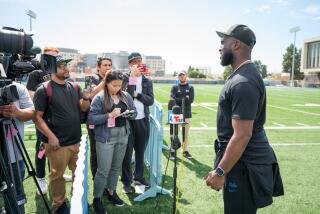Track Face Lift Changing Complexion of CSUN’s Program
- Share via
To those who know little about track and field, it might have looked like some kind of undersized aviary with its 20-foot high steel posts and green wire mesh.
But to Don Strametz, Cal State Northridge’s men’s and women’s track and field coach, the new hammer cage at the renovated CSUN track complex is a symbol of hope and rejuvenation for a program whose reputation hit rock bottom last year when a substandard facility forced the cancellation of several meets.
“It really stands out from the street,” Strametz said. “To me it says, ‘Hey, that’s a track facility. That’s not just a track with a grass field inside.”
The hammer cage is part of a $565,000 face lift the dilapidated track complex has undergone.
When the Matadors host the Northridge Invitational on March 23, competitors will run, jump and throw at a facility that includes a new all-weather nine-lane 400-meter track, four long/triple jump pits, two shotput and discus rings and the aforementioned hammer cage.
A pole vault runway, steeplechase water jump--which has been moved from the inside to the outside of the track--and a huge tartan area at the north end of the infield that will accommodate two high-jump pits and a javelin runway are also new.
Permanent stands are still absent, but if they’re in place by the fall as expected, Northridge will finally have a facility worthy of a NCAA Division I school.
The track and field complex will be so state-of-the-art that the Matadors are scheduled to host the 1997 California-Nevada State championships.
“It’s the centerpiece for what hopefully will become a series of new facilities out here,” Strametz said. “I’m really excited about it.”
Strametz’s excitement is understandable.
The Matador women’s coach since 1981 and the men’s since ‘86, he has yearned for a new track longer than anyone.
He originally thought construction would start in 1993. It didn’t happen, but his hopes were renewed when he received a letter on Jan. 14, 1994, stating that the school had set aside the money for the upgrade.
Those plans were put on the back burner three days later, however, when the Northridge earthquake struck.
After a Northridge fee referendum--which asked students to pay an extra $27 per semester to help the school’s athletic program--passed on the third and final try last March, construction was supposed to begin in May. But because of administrative red tape, as Strametz likes to call it, work did not start until December.
The late start meant the track wasn’t finished in time to host the Northridge-Alemany Relays on Mar. 9, but it will be ready for competition by next week.
“I never gave up,” Strametz said of his hopes for a new facility. “That’s not in my personality. But I was way past the point of being frustrated for a long time because of the politics involved.”
With the track facility near completion, Strametz can even joke about the delays.
“We worked out on the new track for the first time last week,” he said, “and one of the kids came up to me and said, ‘It’s nice to finally see it. You told me that we’d have it three years ago.’ ”
The renovated facility combined with a new weight room, an increase in scholarship money and a move to the Big Sky Conference in the fall should improve the caliber of athlete Strametz and his coaching staff are able to successfully recruit.
Strametz and Co. have done an admirable job recruiting on what most Division I schools would call a shoestring budget, but they’ve been unable to attract the elite high school athletes.
They’ve signed several athletes who placed fifth or sixth in the State championships in their respective events, but they’ve failed to land a state champion since moving to the Division I level in the fall of 1990.
“The new facilities, the new conference and the increase in scholarship money should improve our recruiting by 30-40%,” Strametz said. “We should be able to get kids that we couldn’t get before.”
The increase in scholarship money should be a huge help as the number of full scholarships for the women’s team will jump from seven to the NCAA maximum of 16 and the men’s will go from 6 1/2 to eight or nine.
That should allow Strametz to do what had heretofore been unthinkable: offer an incoming athlete a full ride.
Even Darcy Arreola, the 1991 NCAA champion in the women’s 1,500 meters, was on a partial scholarship at Northridge.
Arreola was an anomaly, however. State high school champions--she won the 1,600 for La Mesa Grossmont in 1986--rarely attend four-year schools on partial scholarships.
The rule of thumb is that you must offer state champions a full scholarship if you want them to come to your school. Strametz knows that, and now that he has the resources is looking forward to doing it.
“We’re out there going after some pretty big people,” he said. “In April, I’d like to be able to say, ‘Guess who we got?’ ”
More to Read
Go beyond the scoreboard
Get the latest on L.A.'s teams in the daily Sports Report newsletter.
You may occasionally receive promotional content from the Los Angeles Times.










